Domingo Marcos Durán (circa 1465 to 1530) was the first person to publish a treatise on music in the Castilian language.1 His Lux Bella, a ten-page work on musical rudiments and plainchant with a fourteen-page tonary, was printed in Seville in 1492 by the cuatro alemanes compañeros.2 On the tenth page of this historic little volume Durán provided a remarkable circular diagram of the hexachordal system which is reproduced here as Figure 1.3
Figure 1. The Wheel of Music. Durán, Lux Bella of 1492, p. 10
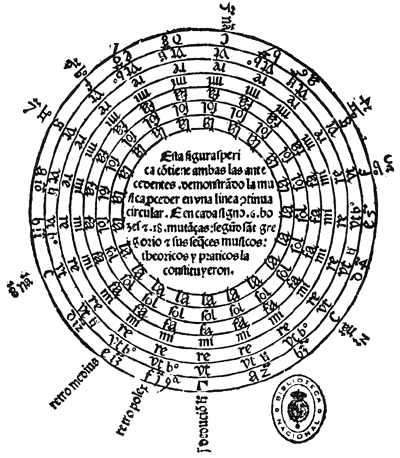
It is the purpose of this article to examine Durán's unique musical circle and the contributions to traditional hexachordal theory that are represented by his circle.
Lux Bella enjoyed sufficient popularity to be issued in two further known editions. On June 16, 1509 a revised version of Lux Bella was printed in Salamanca, and in 1518 Jacopo Cromberger printed a third edition in Seville.4 Both the first and second editions of Lux Bella have appeared in modern facsimile editions.5
In Lux Bella Durán presented the elements of a basic musical education and plainchant in terse language. While many points were presented successfully with a brief definition, others needed elaboration to be understood fully. On June 17, 1498 Durán published in Salamanca a 75-page work entitled Comento sobre Lux Bella which follows the text of Lux Bella and expounds on every statement that was made in the earlier work. About 1507 Durán published a third treatise entitled Sumula de canto de organo, the earliest treatise in Castilian devoted entirely to polyphony.6 Durán's collected writings consequently form a comprehensive treatment of musical practice in Spain at the turn of the sixteenth century.
That Durán wrote in Castilian signifies that he chose to write for a local audience and not to seek an international reputation. Since on the first page of the Comento Durán stated that he had acquired a university education in the liberal arts and in philosophy, this choice was most likely due to his goals in writing and not to a lack of ability to express himself in Latin.7 The most reliable evidence concerning Durán's purpose can be found in his own works. In the introduction to his Comento Durán states
I resolved to prepare to open that road which guides us to the glorious city of music. It seems to me, without all-consuming arrogance, that making this journey briefer and at a smaller cost of fatigue not only to those who are of subtle cleverness, but also to those who are of limited ability, is in order.8
Durán's purpose was not to produce a learned discourse for scholars, one that discussed new theories or complicated issues; rather it was to provide a basic musical education for even the less-than-bright novice. Although it was to be expected that Durán's readers would have at least a basic understanding of Latin, the sole use of Latin would provide an unneeded obstacle for a person struggling to learn fundamentals. Consequently the main focus of Durán's works is a practical one: how to sing plainchant properly, how to read mensural notation, and how to compose polyphony. Theoretical concepts are discussed only to the extent that they enable the reader to remember or to understand the important and practical points. Nevertheless, in his efforts to organize the fundamental theoretical concepts of his age into a consistent, systematic, and exhaustive order for his students, Durán presented in his Lux Bella, a beginner's manual, one of the most complete and innovative discussions of the hexachordal system that was published in his age.
Although the unique features of his theoretical organization were present in the Lux Bella of 1492, Durán did not openly supersede tradition. However, by the publication of the Comento he had crystalized his ideas concerning the structure of the hexachordal system into a new form, and thus we can trace the process by which Durán put aside convention to create a more systematic organization.
The traditional organization of the hexachordal system with seven overlapping hexachords, three hard, two natural, and two soft, is the structure which Durán presented in the Lux Bella of 1492. Reproduced as Figure 2, Durán's diagram of the traditional hexachordal system delineates the identical structure that was given by his contemporaries Johannes Tinctoris (circa 1475),9 Bartoloméo Ramos de Pareja (1482),10 Guilielmus Monachus (1480-90),11 Adam van Fulda (1490),12 Franchinus Gafurius (1496),13 Johannes Cochlaeus (1511),14 Heinrich Glarean (1516),15 Andreas Ornithoparchus (1517),16 and a host of other theorists as widely separated in time as Jerome of Moravia (13th century),17 and Thomas Morley (1608).18
Figure 2. The Hexachordal System. Durán, Lux Bella of 1492, p. 1.
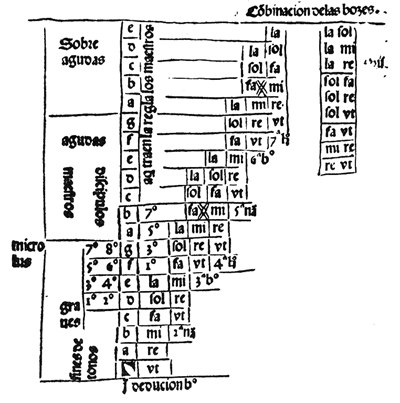
This conventional structure represents the most commonly used notes of plainchant and polyphony in the Middle Ages and the Renaissance, C, D, E, F, G, A, B-flat, B. Durán referred to the normal hexachordal system as the hexachords of plainchant (canto llano) or "true music" (musica real).19
Owing to a printing error in Figure 2 the first hexachord (deducion) is designated as soft; it should be hard, and this mistake was corrected in subsequent editions of Lux Bella. Although Durán consistently used the flat sign to indicate the soft propriety, he used the natural and sharp signs interchangeably to indicate the hard propriety. In Figure 2 the propriety of the fourth hexachord (with ut in grave G) is designated with the natural sign; however, the third degree above it is labeled as B fa-sharp mi instead of the more common B fa-natural mi. This diagram contains several other interesting features. The nine pairs of vocables (bozes) on the extreme right show the possible mutations of vocables. The box with numbers in the grave section to the left of the letters denotes the finals of the modes (fines de tonos). Finally, the numbers to the right of the letters in the grave and acute sections show what pitch is represented by the line in chant that is notated with heightened neumes on a single-line staff.
As a theoretical basis for music the standard hexachordal system had inherent shortcomings which were acknowledged even in its own age. As early as 1482 Bartoloméo Ramos de Pareja proposed an octave scale to avoid some of the problems associated with solmization and musica ficta, although he had presented the traditional seven hexachords and the Guidonian hand earlier in his treatise.20
The hexachordal system had a fixed gamut of two octaves and a major sixth. While this range is more than adequate for plainchant, vocal polyphony and instrumental music could easily exceed the theoretical compass. Concerning this difficulty, major fifteenth- or early sixteenth-century theorists were silent, or said that notes beyond the compass of the system should be referred back an octave to the analogous note within the gamut. This correlation was possible, as Glarean explained, because if one A had three vocables, then every A should.21 Still, Glarean's statement did not provide a solid theoretical justification for the extra notes and syllables that were needed. Some theorists, such as Tinctoris in his Expositio manus22 and Gafurius in his Practica musicae,23 said nothing concerning the fixed range of the system.
One solution to the limited gamut is simply to include additional hexachords within the normal system. Vanneo Stephano added an octave below the traditional gamut and another octave above it by means of six supplemental hexachords in his Recanetum de musica aurea of 1553.24 Likewise, in one of the examples of his Compendium musices of 1552 Adrian Petit Coclico gave a structure of 11 hexachords, two below and two above the traditional system.25 The range covered by these expanded systems was large enough to account for the compass of a four-octave keyboard instrument.
Another weakness of the standard hexachordal system was that the lowest and highest letters lacked some of the vocables which were found in the corresponding central letters. Conspicuously absent was fa in the grave mi-natural, thus there was no B-flat in the grave octave. Even in plainchant the low B-flat is sometimes used, as in the introit "Dicit Dominus,"26 and so the lack of this pitch in the theoretical system was a serious omission.
The vocables and pitches which were lacking within the normal hexachordal system were supplied by means of the hexachords of musica ficta, the conjunctae. These supplementary hexachords possessed an ut in letters other than C, G, and F. However, the Renaissance musician of Durán's era did not think of the hexachord as being transposable by placing ut at any pitch within the system in the same way that a major scale may be transposed.27 Instead, the hexachords added to the traditional system were created from the need to mutate into a hexachord outside the system in order to sing an altered pitch. Since in hexachordal theory a semitone could exist only between the vocables mi and fa, any pitch not in the normal seven hexachords would have to be sung as either mi or fa. For example, if one wished to produce the pitch between D and E, one would have to sing mi in D and then fa above in E (E-flat). (It would also be conceivable to sing fa in E [E-natural] and mi below in D [D-sharp] ). The letter (E) whose position in the hexachordal system had been altered (to E-flat) through the use of an added vocable (fa) was called a conjuncta since two different pitches (E and E-flat) were joined together in that single position.28 To a Renaissance musician the use of a single vocable implied that the other five vocables of the hexachord existed in their proper relationship. Thus the fa in E (E-flat) mentioned above would also produce a hexachord which had ut a perfect fourth below in B (B-flat), re in C, mi in D, sol in F, and la in G. The auxiliary hexachord which was produced by the semitone foreign to the traditional system was also called a conjuncta after the altered pitch was created.29 Thus one must determine from the context whether the term conjuncta refers to an altered pitch or to the concomitant hexachord. Renaissance theorists often disagreed as to the exact number and position of the conjunctae.
One of the earliest thorough discussions of the conjunctae is found in an anonymous French treatise written about 1375 and now in the music library of the University of California.30 According to the anonymous author grave B-flat was provided by an eighth hexachord added "by art" to the normal seven and there were ten conjunctae: grave A-flat, C-sharp, E-flat, F-sharp; acute A-flat, C-sharp, E-flat, F-sharp; and superacute A-flat and C-sharp.31 The writer also stated, in effect, that the same conjunctae that were indicated by C-sharp and F-sharp might also be indicated by D-flat and G-flat. This enharmonic substitution would mean that a single conjuncta might generate two different hexachords. For example, C-sharp would be sung as mi in C and would create an ut in A-natural; D-flat would be sung as fa in D and would create an ut in A-flat.32 Not all later theorists agreed with the possibility of enharmonic substitution.33
Another discussion of the conjunctae is found in the Declaratio musicae disciplinae (circa 1440) of Ugolino of Orvieto.34 Ugolino added three hexachords below Gamma: one on F, one on C, and another of musica ficta with an ut in D. According to Ugolino there were eight conjunctae: F-sharp below Gamma; grave B-flat, E-flat, and F-sharp; acute A-flat, E-flat, and F-sharp; and superacute A-flat.35 In discussing the division of the monochord according to musica ficta, Ugolino provided a chromatic semitone both above and below all whole tones in the normal system; however, all of these chromatic notes were labeled as musica ficta and no attempt was made to incorporate these notes into the traditional hexachord system.36
An extensive discussion of the conjunctae is also found in Anonymous XI (mid-fifteenth century).37 This anonymous author provided for eight conjunctae: grave A-flat, E-flat, F-sharp; acute A-flat, C-sharp, E-flat, and F-sharp; and superacute A-flat. As a footnote he also suggested that mi might be sung in D-sharp (a semitone below E) although he did not include this chromatic note in his discussion of the eight conjunctae.38
Many theorists around the turn of the sixteenth century were curiously evasive or silent concerning the exact number, nature, and use of the conjunctae. Tinctoris said nothing about musica ficta in his Expositio manus, and Adam von Fulda was also silent concerning the conjunctae in his Musica. Likewise in the discussion of the hexachordal system in his De preceptis artis musicae, Guilielmus Monachus did not mention the conjunctae.39 In his Practica musicae Gafurius mentioned the use of musica ficta (C-sharp, F-sharp, G-sharp and E-flat), but he made no systematic attempt to organize the possible chromatic notes within the hexachordal system.40 Johannes Cochlaeus was equally vague in his discussion of musica ficta in his Tetrachordum musices,41 and Heinrich Glarean completely avoided the issue of the conjunctae in his Isagoge.
Andreas Ornithoparchus was more specific in his 106-page Musicae activae micrologus of 1517,42 According to Ornithoparchus the conjunctae were of two kinds, the "tolerable" (tollerabiles) and the "intolerable" (intollerabiles) ones. A tolerable conjuncta occurred when a vocable was sung in a letter which was not given that vocable by means of the normal seven hexachords; however, that vocable was found in the analogous letter an octave away, as when mi was sung in grave A re, or la was sung in grave D sol re. This additional conjuncta would imply a hexachord with an ut below Gamma. An intolerable conjuncta occurred when a vocable foreign to the letter of its octave was sung, such as fa in E la mi (E-flat) or mi in F fa ut (F-sharp). According to Ornithoparchus there were eight normal conjunctae, although there could be more: grave A-flat, E-flat, F-sharp; acute A-flat, C-sharp, E-flat, F-sharp; and superacute A-flat.43 According to Ornithoparchus's doctrine the missing vocables in the lowest and highest notes, presumably also the fa in mi-natural, were given to those letters by means of tolerable conjunctae, that is, conjunctae that did not alter the pitches of the melody.
Durán gave still more information concerning the conjunctae. According to Durán in the Comento where he explained the theory in more detail than in Lux Bella, the conjunctae were called musica ficta, or "false music," not because they were false but because they were seldom used.44 A conjuncta was the place where two different pitches were joined together in a single letter (except for B fa mi-natural, which was already found in the usual system).45 The great difference between the normal hexachords and those of the conjunctae was that the generation of the normal hexachords was found in the syllable ut, but in the conjunctae the source of the hexachords was either the syllable mi or fa46. In order to sing a conjuncta one would have to sing the pitch not found in the normal hexachords of the system. The letters for which mi was sung in place of the normal fa were C (C-sharp) and F (F-sharp), and these substitutions were called "hard" conjunctae owing to their resemblance to the mi in B fa-natural mi which was hard natural. Those letters for which fa was sung instead of mi were E (E-flat), and A (A-flat), and were said to be "soft" after the fa in B fa-natural mi which was soft B.47
Since the conjuncta was created by singing mi where there was normally a fa and vice versa, it is easy to see that according to Durán's theory there could be no variation of pitch within the letters D (la sol re) and G (sol re ut), since these two letters had no mi or fa by means of the normal hexachords. Consequently the twelve pitches which were available within the octave according to Durán were C, C-sharp, D, E-flat, E, F, F-sharp, G, A-flat, A, B-flat, and B.
Durán then presented in Lux Bella all of the conjunctae in a table which is similar to the one he had given for the normal hexachordal system. This table is reproduced as Figure 3.
Figure 3. The Conjunctae. Durán, Lux Bella of 1492, p. 8.
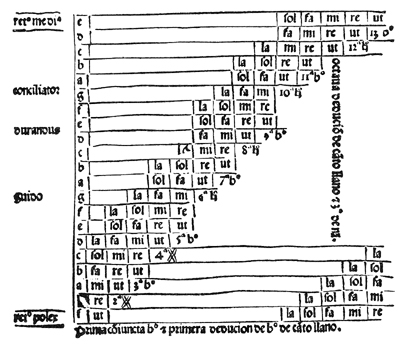
The "tolerable" conjunctae of Ornithoparchus are present in Figure 3 within the hexachord which has an ut in the F below Gamma ut (retropolex F), which Durán called the first conjuncta, and also in the hexachord which has an ut in superacute C sol fa ut, which Durán called the eighth hexachord of plainchant. Durán also designated the first conjuncta to be the first soft hexachord of plainchant, and thus implied that it had a dual function. While the first conjuncta of Durán supplied a pitch which was missing in the normal system (grave B-flat), this hexachord also was generated by an ut in retropolex F48 and it completed the normal system by providing vocables that were missing at the extremes of the range as did the hexachord which began on superacute C sol fa. Durán might have called the hexachord which began on superacute C sol fa the twelfth conjuncta, but since it varied no pitches and was generated by an ut, he may have felt that it belonged only to the normal system. Here Durán faced a dilemma. These two hexachords clearly were not part of the traditional system, yet they were generated in a similar manner and they performed an analogous function to hexachords which began an octave away and were within the system, so that they were not musica ficta either. Because of these factors, Durán's solution to the problem in 1492 was to present these hexachords away from the traditional seven and among the conjunctae, yet to establish a distinction between the true conjunctae and those two extra hexachords which functioned in the same manner as the seven hexachords which were within the normal system.
Durán also presented the twelve true conjunctae in his table, two more than the anonymous French author gave, and four more than Ugolino, Anonymous XI, and Ornithoparchus gave, by giving hexachords which provided chromatic notes throughout the range as well as in the central portion. However, he added no different pitch names to those that the other theorists had given.
Figure 3 is noteworthy for another feature. When the hexachords ascend beyond superacute (retromedius) E la instead of continuing beyond the range of the system, the hexachords return to begin the same order as from retropolex F, and when they descend below retropolex F they begin the same order as from superacute E la. By adding a single letter (retropolex F) to the traditional gamut and by means of returning and overlapping hexachords. Durán closed the hexachordal system and was thus able to extend the range indefinitely. No instrument could play a note that was so high or low that it was beyond the compass of Durán's system.
This concept of periodicity in the hexachordal system also occurred in Le Droict chemin de musique of Louis Bourgeois in 1550 and in the Rudiments de musique pratique of Maximilian Guilliaud in 1554.49 In these later treatises, the retropolex F was given below Gamma as it was in the Lux Bella of 1492.
To indicate that the hexachordal system was closed, Durán likened it to a wheel. The analogy is indeed a good one. When a wheel makes several complete turns, the same points on it touch the ground in the same order as they did before, but new ground is covered. In the same way, as the hexachordal system was circled in either direction, when superacute E la or retropolex F fa ut was passed, the same order prevailed as if beginning over again, but always the direction was the same and new pitches were sung.
In order to prove that the new system could be likened to a wheel, Durán presented a unique circular diagram at the end of the text of Lux Bella (Figure 1), which contains all the hexachords in the system, the normal ones as well as the ones of the conjunctae. The chart is arranged so that the overlapping and the return of the hexachords as well as the six vocables which are possible in every letter can be seen in their proper relationship. Figure 4 is a modern, translated version of Durán's musical wheel.
Figure 4. The Musical Wheel of Domingo Marcos Durán.
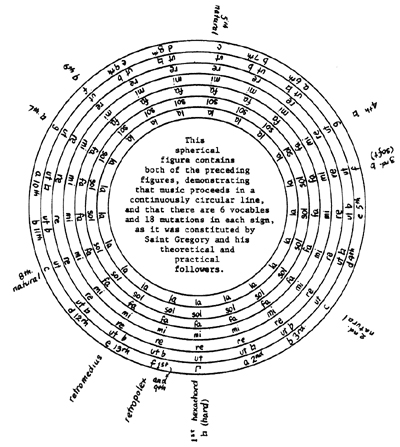
The 21 letters of the hexachordal system are given between the first and second circles. Outside the first circle are indicated the beginning of the normal hexachords along with the appropriate proprieties. To see the location of each of the overlapping hexachords, one must begin within the second circle with an ut and proceed counterclockwise, progressing inward for each succeeding syllable. For example, the first hard hexachord begins with the ut within the second circle of the letter Gamma, the re is located within the third circle of A, the mi is within the fourth circle of B, and so forth to the la which is within the seventh circle of E.
The hexachords of the conjunctae are labeled within the first circle to the right of their respective letters in order to distinguish them from the normal hexachords. The proprieties of the conjunctae are given within the second circle to the right of the appropriate ut. The conjunctae are also read counterclockwise moving inward. In this figure one can see that each letter has all the six vocables, and each of those vocables is given to it by means of a different one of the overlapping hexachords. In the circle Durán designated the hexachord beginning on retropolex F to be the ninth hexachord of plainchant as well as the first conjuncta. In the table of the conjunctae he called it the first hexachord of plainchant. In the circle Durán apparently began his numbering of the normal hexachords with the traditional Gamma.
Durán's system is exhaustive; no further additions may be made, nor may additional musica ficta be used without weakening the consistency of the system. The reason that there could be no more conjunctae is that an enharmonic conjuncta would necessitate another hexachord which would be sung with the same vocables in the same letters, and yet it would be different in pitch. For example, A-flat was created by singing fa in the letter A. The hexachord thus created placed an ut in E-flat, the fa in the letter E; a re in the letter F; a mi in the letter G; a sol in B-flat, the fa in the letter B; and a la in C. If one wished to use G-sharp, then one would have to sing mi since this note would require a hard conjuncta, a note which would be sung a half step higher than normal The hexachord thus created would place an ut in E; a re in F-sharp, the mi in the letter F; a fa in A; a sol in B; and a la in C-sharp, the mi in the letter C. Since in order to be consistent the combination of a vocable with a letter must have a definite position within the hexachordal system, enharmonic accidentals cannot be accounted for without weakening all the relationships because such accidentals necessitate that a vocable with a letter not have a definite position. If further pitches, enharmonic to those twelve in each octave specified by Durán, were to be used and accounted for, a new theoretical system would have to be devised.
By the time the Comento was published in 1498, Durán had decided to break with tradition in order to be thoroughly consistent. The Comento contains no diagrams, but it corrects the Lux Bella of 1492 with regard to the distribution of hexachords between those of the normal system and those of the conjunctae. In Lux Bella Durán had assigned the hexachords beginning on retropolex F and superacute C among the normal system, although he had listed them with the conjunctae; in the Comento, however, he decided that they should be listed with the normal hexachords so that there were nine (not seven) overlapping hexachords in the regular system, three per octave. In order to have Gamma as the lowest note, as was traditional, in the expanded version of the normal hexachordal system retropolex F had to be placed above superacute E la instead of below Gamma.This philosophy is illustrated graphically in the diagram of the hexachordal system from the Lux Bella of 1509 which is reproduced as Figure 5.
Figure 5. The Hexachordal System. Durán, Lux Bella of 1509, p. 2.
>
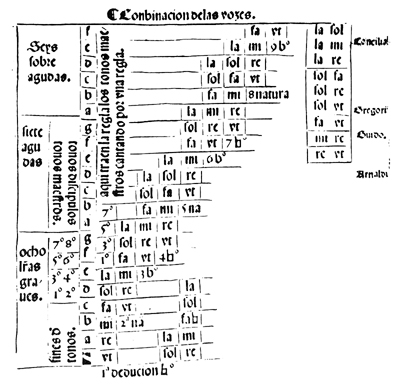
With nine hexachords assigned to the normal system, the number of conjunctae was reduced from 13 to 12, as can be seen in the figure of the conjunctae from the Lux Bella of 1509 reproduced as Figure 6.
Figure 6. The Conjunctae. Durán, Lux Bella of 1509, p. 9.
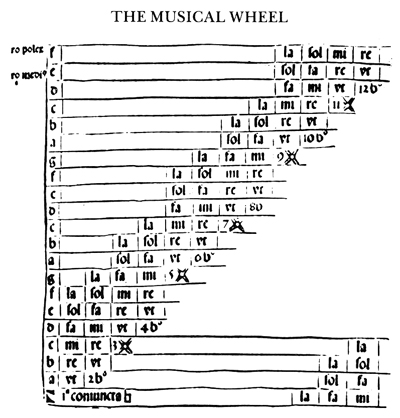
Since the reorganization of the hexachordal system added no new notes or features to the entire system given in the Lux Bella of 1492, the musical wheel in the1509 version corresponds with the earlier one except for renumbering of the hexachords.
In an age which favored number mysticism, Durán's revision had the added advantage of producing "better" numbers than the traditional system. There were nine hexachords (thrice perfection) in the normal system instead of seven, and 21 letters (thrice seven) instead of 20. Of course there remained six vocables in each letter (twice perfection), 18 mutations of vocables (thrice six), and 21 hexachords. That Durán chose to arrange the hexachordal system into a wheel is also symbolic, since a circle represented perfection to the Renaissance musician.50 Concerning the perfection of his new system Durán said in the Comento:
Moreover, even though it appears to be a new thinking, recently brought forth in music, it can be readily approved and maintained because experience shows us by means of true reasons and principles that are agreeable to the intellect that there are nine hexachords of plainchant and twelve of the conjunctae, which are twenty-one, by means of which music is perfected. . . . "A continously circular line" is said when the end reaches and takes the beginning, and so music appears perfected because a thing is perfect when the end is joined to the beginning, or when an addition cannot be made to it; and plainchant in bringing all these vocables: ut, re, mi, fa, sol, and la in each sign, and in making eighteen mutations with them cannot be made more perfect.51
It is to Durán's credit that he was able to present the complete hexachordal system so clearly in a beginner's manual; he was explicit where many others were vague. Although he was primarily concerned with practical matters, he provided a theoretical basis for the syllables lacking at the extremes of the system and extended its range indefinitely. By adding only a single letter and two hexachords to the traditional seven he accomplished more with fewer additions than did Stephano or Coclico. He presented all the possible conjunctae when others had avoided or ignored the issue. Finally, in his musical wheel he presented a unique graphic representation of the hexachordal system at its fullest consistent extent, one which incorporated his significant innovations.
1Robert Stevenson, Spanish Music in the Age of Columbus (The Hague: Martinus Nijhoff, 1960), pp. 64-65.
2The cuatro alemanes compañeros have been identified as Pablo de Colonia, Juan Pegnitzer, Magno Herbst, and Tomás Glockner. For details concerning the firm see F.J. Norton, Printing in Spain 1501-1520 (Cambridge: Cambridge University Press, 1966), pp. 8-9 and 149.
3The pages in Durán's treatises are neither numbered nor foliated. For purposes of reference the first page of text will be considered page one.
4For a detailed discussion of the differences between the three editions of Lux Bella see Roger C. Vogel, The Theoretical Writings of Domingo Marcos Durán: A Translation and Commentary (Ann Arbor: University Microfilms 76-10,064), pp. 22-23, 43-44 and 128-174.
5Domingo Marcos Durán, Lux Bella, ed. José Subirá (Barcelona: Ediciones Torculum, 1951, facsimile reprint of the 1492 edition); and Domingo Marcos Durán, Lux Bella, ed. Constanca Capdiville, Rei Musicae Portugaliae Monumenta No. 3 (Lisbon: Casa de Ramos, Alfonso, & Moita, Lda., 1969, facsimile reprint of the 1509 edition).
6Stevenson, op. cit., p. 69.
7Vogel, op. cit., pp. 177-178.
8"Acorde tomar haldas en cinta para abrir este camino que nos guje a la gloriosa cuidad de musica: el qual a mi ver fuera de toda soberuia es para hazer muy breue la jornada y a menos costa de fatiga no solamente alos sotiles de ingenio mas avn alos que son de muy baxa ralea." Durán, Comento sobre Lux Bella (Salamanca, 1498), p. 1.
9Johannes Tinctoris, Expositio manus, trans. Albert Seay, Journal of Music Theory IX (Winter 1965), 194, 205.
10Bartoloméo Ramos de Pareja, Musica practica, ed. Johannes Wolf (Leipzig: Breitkopf und Härtel, 1901, reprint of the 1482 edition), pp. 11-13.
11Guilielmi Monachi, De preceptis artis musicae, ed. Albert Seay, Corpus Scriptorum de Musica No. 11 (Rome: American Institute of Musicology, 1965), pp. 30-33.
12Martin Gerbert, Scriptores ecclesiastici de musica sacra potissimum, 3 vols. (Typis San Blasianis, 1784), III, 345.
13Franchinus Gafurius, Practica musicae, trans. Clement A. Miller, Musicological Studies and Documents No. 20 (Dallas: American Institute of Musicology, 1968), pp. 9 and 20.
14Johannes Cochlaeus, Tetrachordum musices, trans. Clement A. Miller, Musicological Studies and Documents No. 23 (American Institute of Musicology, 1970), p. 37.
15Heinrich Glarean, Isagoge in Musicen, trans. Francis Berry Turrell, Journal of Music Theory III (April 1959), 98 and 116.
16Andreas Ornithoparchus and John Dowland, A Compendium of Musical Practice (New York: Dover Publications, 1973, facsimile reprint of the 1517 and 1609 editions), p. 14.
17Charles Edmond Henri de Coussemaker, Scriptorum de musica medii aevi, 4 vols. (Paris: A. Durand, 1864-76), I, 21.
18Thomas Morley, A Plain and Easy Introduction to Practical Music, ed. Alex Harman (New York: Norton, 1973, reprint of the 1608 edition), p. 11.
19Vogel, op. cit., pp. 314-316.
20Ramos de Pareja, op. cit., pp. 11-13 and 43-48.
21Glarean, op. cit., p. 119.
22Tinctoris, op. cit., pp. 194-232.
23Gafurius, op cit., pp. 25-42.
24Vanneo Stephano, Recanetum de musica aurea (Kassel: Bärenreiter, 1969, facsimile reprint of the 1553 edition), fol. 11 recto.
25Adrian Petit Coclico, Compendium musices (Kassel: Bärenreiter, 1954, facsimile reprint of the 1552 edition), p. 16.
26The Liber Usualis with Introduction and Rubrics in English (Tournai: Desclée No. 801, 1963), p. 1074.
27Some Renaissance theorists, especially toward the middle of the sixteenth century, did feel that the hexachord might be transposed by placing ut in different letters. See Juan Bermudo, Declaración de instrumentos musicales (Kassel: Bärenreiter, 1957, facsimile reprint of the 1555 edition), fol. 41 recto.
28Gaston G. Allaire, The Theory of Hexachords, Solmization and the Modal System (American Institute of Musicology, 1972), pp. 33-34.
29Stevenson, op. cit., p. 51.
30Oliver Ellsworth, "The Origin of the Conjuncta: A Reappraisal," Journal of Music Theory XVII (Spring 1973), 91.
31Ellsworth, op. cit., pp. 105-108.
32Ibid.
33Most writers specified only one hexachord for each conjuncta. See Ornithoparchus, p. 144 and Anonymous XI, Tractatus de musica plana et mensurabili in Coussemaker, III, 426-429.
34Ugolino of Orvieto, Ugolini urbevetani declaratio musicae disciplinae, ed. Albert Seay, Corpus Scriptorum de Musica No. 7, 3 vols. (Rome: American Institute of Musicology, 1959-62), II, 44-53.
35Ugolino of Orvieto, Declaratio musicae disciplinae, II, 44-53.
36Idem, III, 251-253.
37Coussemaker, III, 426-430.
38Ibid.
39Monachi, op. cit., pp. 30-33.
40Gafurius, op. cit., pp. 145-146.
41Cochlaeus, op. cit., p. 46.
42Ornithoparchus, op. cit., pp. 30 and 144.
43Idem, p. 144.
44Vogel, op. cit., p. 316.
45Idem, p. 314.
46Idem, pp. 315-317.
47Ibid.
48Ibid.
49Louis Bourgeois, Le Droict chemin de musique, ed. Paul-André Gaillard, Documenta Musicologica No. 6 (Kassel: Bärenreiter, 1954, facsimile reprint of 1550 edition), pp. 12-13. Maximilian Guilliaud, Rudiments de musique pratique (Paris, 1554), p. 9.
50Gafurius, op. cit., p. 89.
51"Mas avn que parezca en la musica sentencia noua nouiter allegata: bien se puede aprouar y tener: porque la experiencia nos muestra por verdaderas causas y principios conformes al intellectro ser. ix. deduciones de canto llano y. xij. de conjuntas que son. xxj. por las quales esta la musica perfecta. . . . dizese linea continua circular: quando el fin alcança y toca al principio y asi parecia la musica perfecta ca entonce es perfecta la cosa: quando el fin se junta con el principio o quando en ella no se puede fazer addicion. y no puede ser mas perfecto el canto llano que traer en cada signo todas estas bozes vt re mi fa sol la y fazer con ellas xviij. mutanças." Durán, Comento, p. 65.


